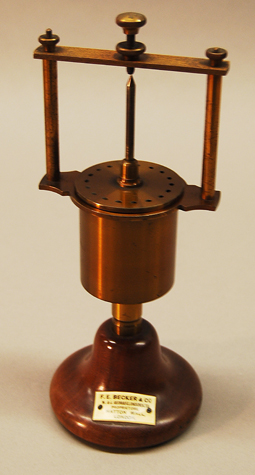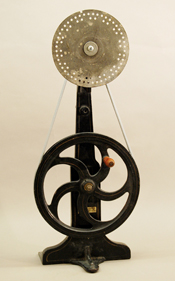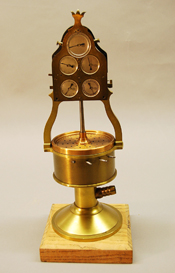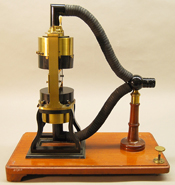The Acoustic Siren
Historical Context
The acoustic siren was one of the fundamental tools of 19th century science. Invented by the French scientist Cagniard de la Tour, in 1819, the siren used a bellows apparatus to force air through two brass disks. As the air passed through holes in the discs, one of which was rotating, it produced a series of regular pressure waves that we perceive as a musical tone. The construction of the siren allowed that tone to be raised or lowered by simply increasing or decreasing the speed of the rotating disc. Perhaps the most important feature of de la Tour’s siren were its’ dials. Connected by gears to the shaft of the rotating disk, they recorded the number of times the disk rotated. This was important because simply multiplying the number of rotations per second by the number of holes in the disk gave the precise frequency of the tone being produced. For the first time, scientists were now able to create tones of specific frequencies, and to measure the frequencies of other sounds by comparing them to the measurable sounds of the siren. As acoustic research developed, several important improvements were made to the siren, and it continued to be an important scientific tool into the early 20th century.
Supporting Artifacts
Demonstration Siren
In its simplest form the siren consists of two metal disks, each having the same number of regularly spaced concentric holes. The lower disk is mounted on the base of the siren, while the upper disk is mounted on a steel shaft just above it. As air is forced through the system, the upper disk begins to rotate. As it spins, the holes in the two disks briefly line up and then quickly close. Each time they do this, a brief puff of air is released. Each of these puffs acts like a single sound wave, and if enough of them are produced we perceive them as a continuous musical sound.
The number of holes in the disk determines the number of “waves” produced on each rotation. And the total number of waves (or puffs of air) per second determines the frequency of the sound produced. As long as air flows through the siren, increasing the speed at which the upper disk rotates will raise the pitch of the sound produced.
Perforated Disk Siren
This is about as simple a siren as it is possible to build. It’s basically a single metal disk with two rows of evenly spaced holes. Here it is mounted on a “Rotator”, a pulley device once common in American classrooms. In this demonstration, as one student cranked the rotator the disk would start spinning rapidly. A second student would then blow air through the holes with a flexible rubber tube. The faster the first student cranked, the higher the tone. The harder the second student blew through the tube, the louder the sound. Although the sounds this apparatus produced were not musical, this was an effective (and inexpensive) device for demonstrating basic acoustic principles.
De La Tour's Siren
Cagniard de la Tour invented his “Sirène” in 1819 and then used it to answer a variety of scientific questions. He used it not only to measure musical frequencies, but also the speed of a mosquito’s wings (10,000 flutters per second). He showed that it worked as a warning signal on ships and reported that it even made a sound underwater (using water pressure instead of air pressure). His siren was later used to measure the speed of sound in water, and it was this property of “being sonorous in the water” that caused him to call it a Siren.
One of the advantages of de la Tour’s design was that it was simple and compact. The same air pressure that made the sound was also used to drive the rotating disc. This was accomplished by drilling the holes in the two discs obliquely, at such angles that the upper disk begins to rotate automatically, much like a turbine, when air pressure is applied. However, this same feature caused one of the siren’s problems. Because it was driven by the same air pressure that produced the sound, producing higher tones on the siren required increased air pressure – which meant that the sound would also be louder. The opposite is true of low notes. Overall, sirens of this design are soft on low notes and shrill on high ones. In terms of making actual measurements, the siren is also limited by its reliance on human hearing. Under ideal conditions, a skilled researcher could use de la Tour’s siren to distinguish between sounds that were a fraction of a wavelength apart.
Dove’s Siren
Around 1840, the Prussian scientist Heinrich Wilhelm Dove invented a new type of siren, designed to produce several tones at once. Unlike the disks in de la Tour’s siren, which only had one ring of holes, the disks in Dove’s siren featured four rings, each with a different number of holes. Four stops mounted below the disks allowed the user to “play” whichever tone, or combination of tones, was desired by simply pulling out the appropriate stop. The five dials on the top of the siren facilitated measuring multiple frequencies.
Dove invented this instrument around the time that he discovered binaural beats, a perceptual artifact produced when tones of slightly different frequencies are heard in different ears. This siren was ideal for that kind of research, as well as for demonstrating interference effects (where sound waves combine to increase or diminish) and for combination tones.
Helmholtz’s Double Siren
In 1862, the German scientist Herman Helmholtz invented another important acoustic instrument, the double siren. The new instrument combined two Dove Sirens, which were positioned to face each other and coupled on the same shaft. Both sirens were also connected to the same air supply, which made it possible to produce a variety of frequencies, all of which would slide up or down the scale as the air pressure was increased or decreased.
The two sirens in this instrument were similar, but not identical. The upper disk had four rings of holes, with 9, 12, 15 and 16 holes respectively. The lower disk also had four rows, but with 8, 10, 12 and 18 holes. The lower siren was rigidly fixed in place, but the upper one had a small crank on the top which allowed it to be rotated. This created “phase effects” between the two sirens and was useful for studying interference effects. Helmholtz also added small brass resonators to each siren. These covered the disks and were intended to reduce the harmonics and produce a more pure tone. Helmholtz described the sound of his instrument as being “full, strong and soft, like a fine tone on the French horn.”




